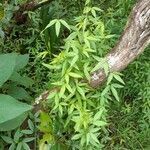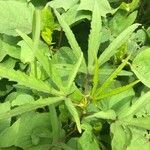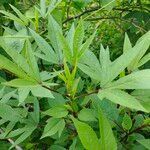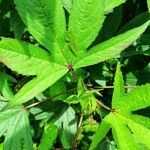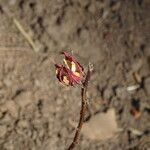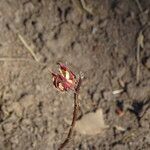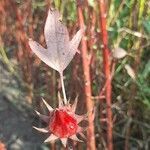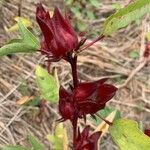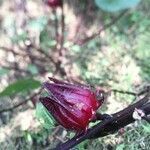Subshrub or shrub 0.6–2 m high. Branchlets with sparsely scattered stellate hairs, and glandular hairs, hairs whitish, yellowish or golden-brownish. Stipules deciduous, subulate to very narrowly triangular, 10–13 mm long, with stellate hairs and glandular hairs. Mature leaves: petiole 30–55 mm long; lamina ovate, unlobed to deeply 1–3-lobed, 80–130 mm long, 55–130 mm wide (the lobes longer than wide), cuneate base, serrate margin, acute, obtuse or acuminate apex, concolorous, the abaxial surface with midrib and primary vein indumentum different to interveinal regions, with glandular hairs, sometimes with stellate hairs and fine bristles, the hairs sparse. Foliar nectary at base of lamina, 1–2 mm long. Flowers solitary in leaf axils, pedunculate, peduncle c 5 mm long, glabrous; pedicel c. 2 mm long, glabrous; epicalyx glabrous, 8–10-segmented, the segments fused at base to 1 mm, straight or incurved, subulate, shorter than the calyx, 8–11 mm long at anthesis, segments 3–5-veined; calyx at anthesis not splitting (5-lobed but not splitting per se), 9–13 mm long, indumentum of scattered fine bristles, calyx nectary present; petals 40–50 mm long, yellow, reddish-purplish petal spot present; staminal column characters not recorded; gynoecium characters not recorded. Capsules broadly ovoid, 18–25 mm long, sparsely hairy with appressed simple hairs, beak c. 2 mm long. Seeds angular-subreniform, c. 5 mm long, glabrous.
Herbs annual, erect, to 2 m tall; stems purplish, robust, glabrous. Stipules filiform, ca. 1 cm, sparsely villous; petiole 2-8 cm, sparsely villous; leaf blade dimorphic; blades on proximal part of stem ovate, those on distal part of stem palmately 3-lobed, lobes lanceolate, 2-8 × 0.5-1.5 cm, base rounded or broadly cuneate, margin serrate, apex obtuse or acuminate, glabrous; basal veins 3-5, glanduliferous along midrib on abaxial surface. Flowers solitary, axillary, subsessile. Epicalyx lobes 8-12, red, lanceolate, connate at base, 5-15 × 2-3 mm, sparsely long hirsute, with spiny appendix near apex. Calyx purplish, cup-shaped, connate for ca. 1/3 length, ca. 1 cm in diam., fleshy, sparsely spiny and coarsely hairy, lobes 5, triangular, 1-2 cm, acuminate. Corolla yellow with dark red center, 6-7 cm in diam. Capsule ovoid-globose, ca. 1.5 cm in diam., densely coarsely hairy. Seeds reniform, glabrous. Fl. summer-autumn.
A branched shrub up to 2 m high. It has reddish stems, leaves and fruit. Different types vary in their height, shape and leafiness. The leaves are 7-10 cm across and lobed. The upper leaves often have more lobes than the lower leaves. The flowers are large and yellow and in the axils of the leaves. They are carried singly. The bracts at the base of the flower are enlarged and form a fleshy red fruit. This capsule is 3 cm long and contains 22-34 seeds. The seeds are dark brown and 4-6 mm long. 1000 seeds weigh about 25 g.
Leaf-lamina up to 15 × 15 cm., suborbicular to elliptic in outline, usually rather deeply digitately 3–5-lobed, usually glabrous or nearly so, lobes narrowly to very narrowly elliptic; petiole up to 10 cm. long, glabrous or sparsely pubescent; stipules up to 10 mm. long, very narrowly triangular.
Flowers 3–5 cm. in diam., pale yellow with purplish-brown centres, solitary, axillary or in racemose inflorescences by reduction of the upper leaves; peduncle up to 2·5 cm. long, glabrous, pubescent or pilose, articulated below the middle.
Calyx up to 3(5) cm. long, red, fleshy, edible; lobes ovate to ovate-lanceolate, joined to nearly half-way, usually with a conspicuous gland on the median vein on the outside of each lobe.
Annual herb, up to 1.5 m high, not aculeate. Calyx fleshy, edible. Bracts of epicalyx not clearly forked. Flowers pale yellow with purplish brown centres.
Epicalyx of 9–10 bracts, glabrous or sparsely pubescent; bracts up to 18 mm. long, elliptic, joined at the base.
Epicalyx and calyx sometimes with scattered hairs and tubercles, becoming succulent
Seeds up to 5 × 4 mm., subreniform, minutely stellate-pubescent, glabrescent.
Erect, slightly branched with smooth or slightly hispid stem, often coloured
Capsule up to 20 × 18 mm., ovate-acuminate, glabrous or somewhat pilose.
Annual herb up to 1·5 m. tall; stems glabrous or almost so.
Flowers an inch or more long, yellow with a purple centre
Widely cultivated and variable in form and size.
